Search for articles or browse our knowledge portal by topic.
Structural Concrete Coatings

Preventive maintenance is a key action in extending the service lives of bridges (i.e., bridge preservation). Structural concrete (reinforced and prestressed concrete) is the most common bridge material, accounting for over 90 percent of all bridge elements – superstructures, substructures and decks. Maintenance painting of concrete bridges not only protects the structural concrete from deleterious attack, but also provides durable aesthetic treatments for bridges, making them fit better in natural and built environments. It also can highlight the appearance of freshly painted steel members. The primary forms of structural concrete deterioration involve the corrosion of embedded reinforcing or prestressed steel that weakens a structure thereby resulting in concrete cracking and spalling. In addition to improved bridge aesthetics, concrete coatings can resist black mildew stains and simplify graffiti elimination when topcoating is performed with the original finish coat. Currently, gray is the common color used for most KYTC concrete coating work. However, other colors (e.g., white) can be specified when aesthetic concerns are important.
Concrete painting is typically a subtask along with other preventive maintenance tasks including: painting of structural steel, greasing of bearings, cleaning of substructure elements (including trash removal), clearing of drains or improving deck drainage and structural concrete repairs. Usually, it is one of the last tasks performed under preventive maintenance contracts. Concrete coatings can be used on superstructure elements (beams and beam ends and barrier walls) and substructure elements (abutments, diaphragms, piers and pier caps, abutment walls and wing walls, etc.). Decks are not painted although it is possible to coat the undersides of decks extending from fascia girders (i.e., soffits).
Concrete painting can also be incorporated in new construction projects. Similar painting actions are required for new construction and concrete maintenance work. The one drawback in concrete painting of new construction and repaired concrete is that the underlying concrete must be fully cured to receive coatings.
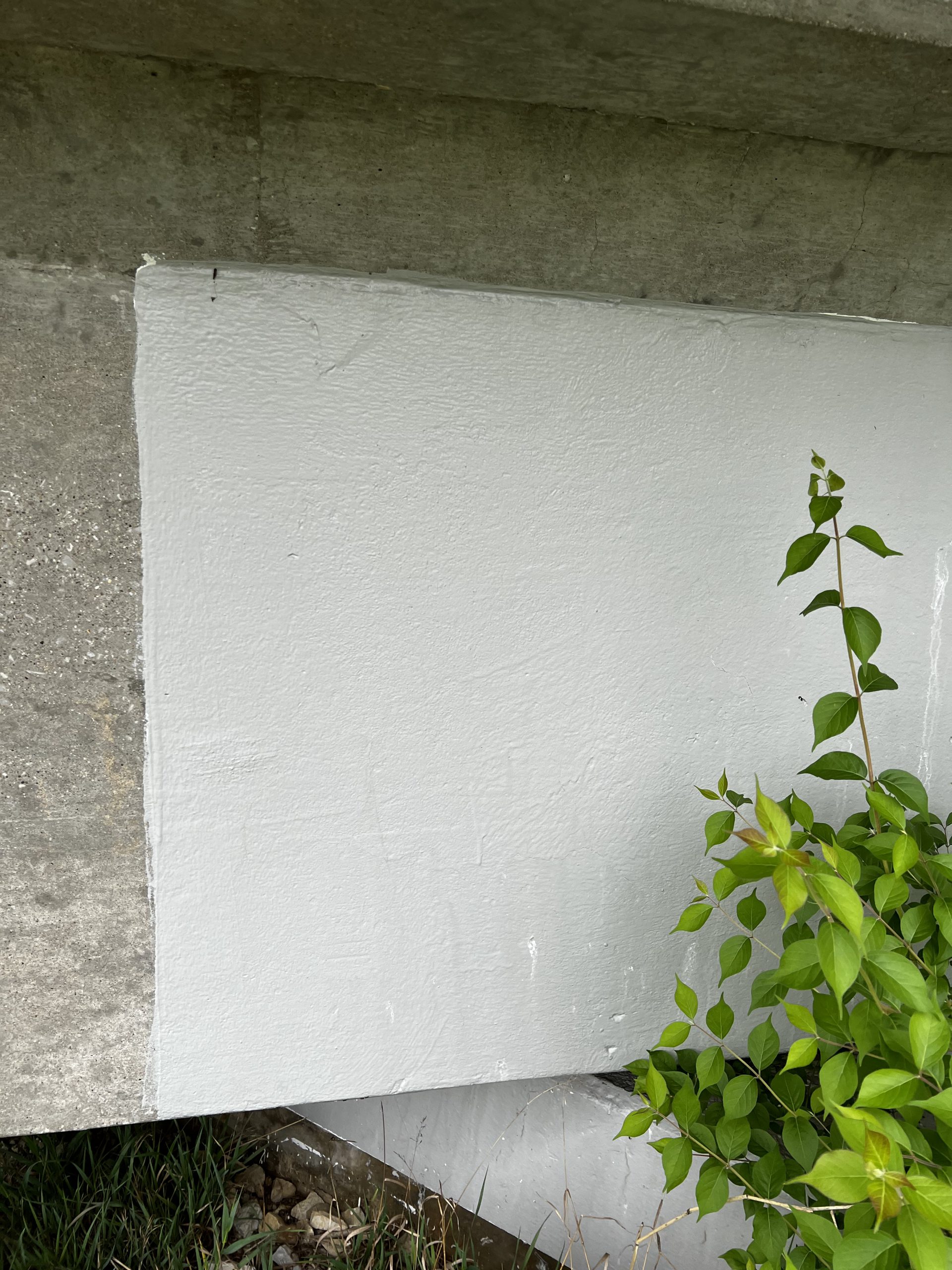
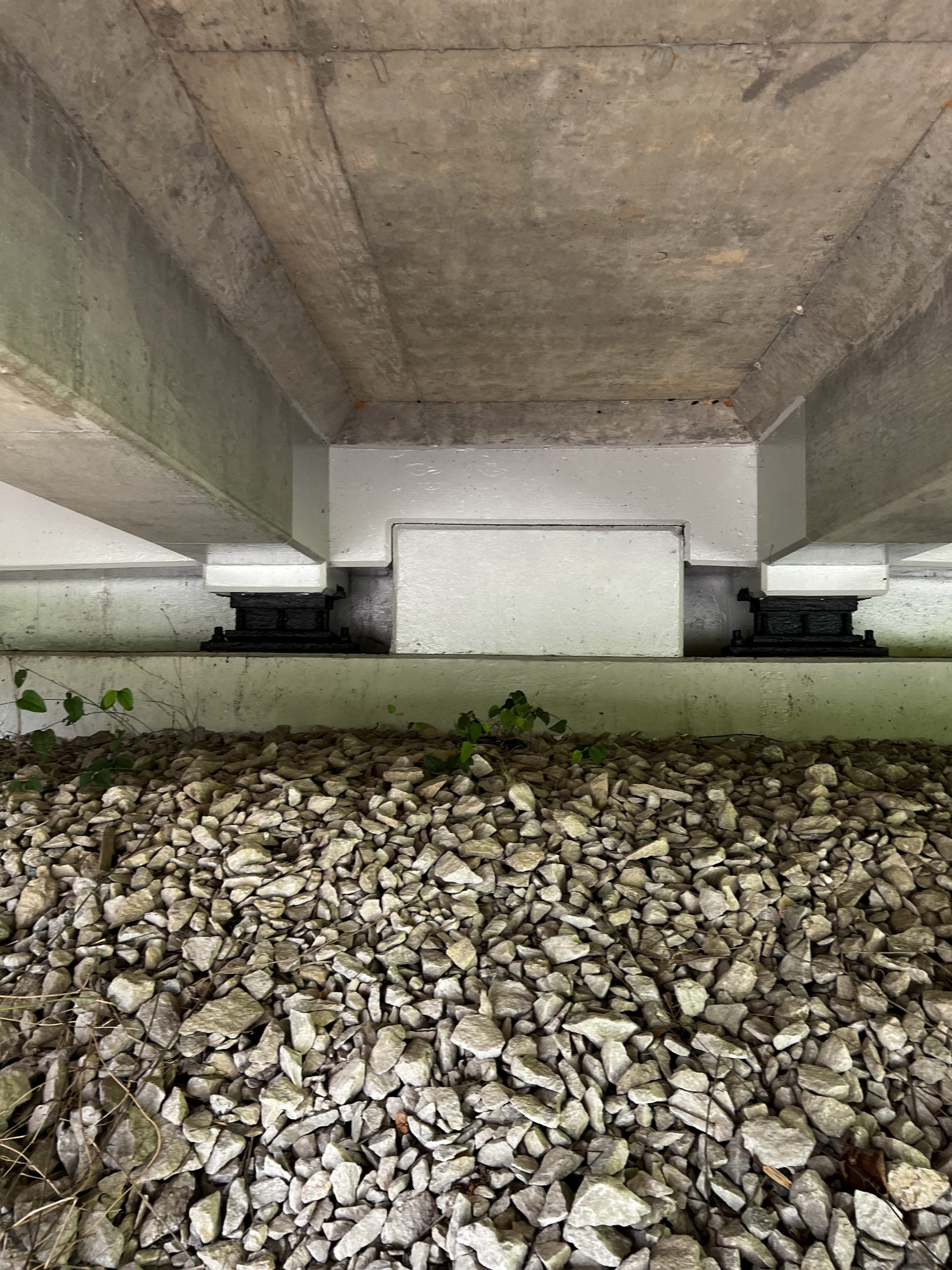
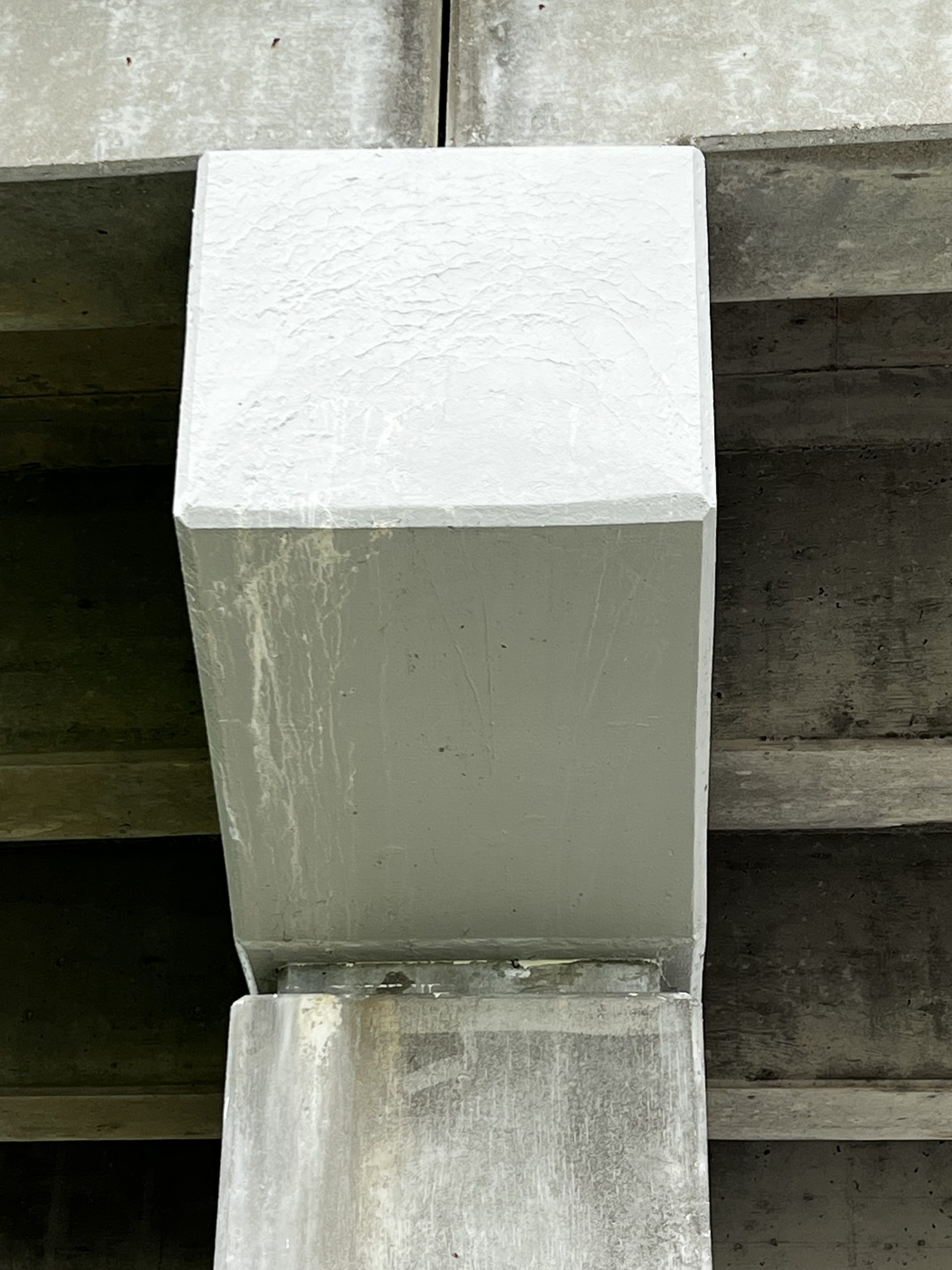
To view definitions of the terms included in this article, please refer to the HKP Glossary.
- Categorical Exclusion
- Chalking
- Coating
- Coating System
- Disbondment
- Laitance
- Pressure Washing
- Primer Coat
- Proposal-Type Bid Package
- Top Coat
Structural concrete is commonly used for superstructure, substructure and deck elements of bridges. Painting of concrete superstructure elements includes diaphragms, fascia beams and beam ends. Substructure painting includes abutments and abutment walls, wing walls and piers. Deck-level painting is performed on concrete barrier walls and soffits.
Substructure elements, especially abutments, will require cleaning operations and possibly debris and vegetation removal. This can include blow-down of concrete surfaces to remove dust. At this point, any drainage issues, primarily clogged drains, can be addressed. Cleaning and painting of structural steel, if needed, is the next step followed by any repairs of distressed (e.g., spalled or cracked) concrete. Depending upon the type of concrete distress, concrete surface washing operations shall proceed during or subsequent to any concrete repairs. Washing operations may be specified for all concrete elements including bridge decks that will not be painted. Pressure washing will be employed using potable water sprayed on the concrete surfaces at 4,000 psi using spray wands equipped with spinner tips to promote cleaning. Operators are to keep the nozzles normal and close to concrete surfaces (within about 12 inches). Once the washing operation is complete, the concrete surfaces must undergo a visual inspection by the Contractor’s QC inspector to verify it meets specified cleaning standards prior to painting. KYTC’s inspector will approve the properly completed task. The concrete is typically allowed to dry for at least 24 hours prior to painting. Atmospheric conditions may allow earlier painting or necessitate a longer drying interval prior to concrete coating.

Concrete abutment before debris removal
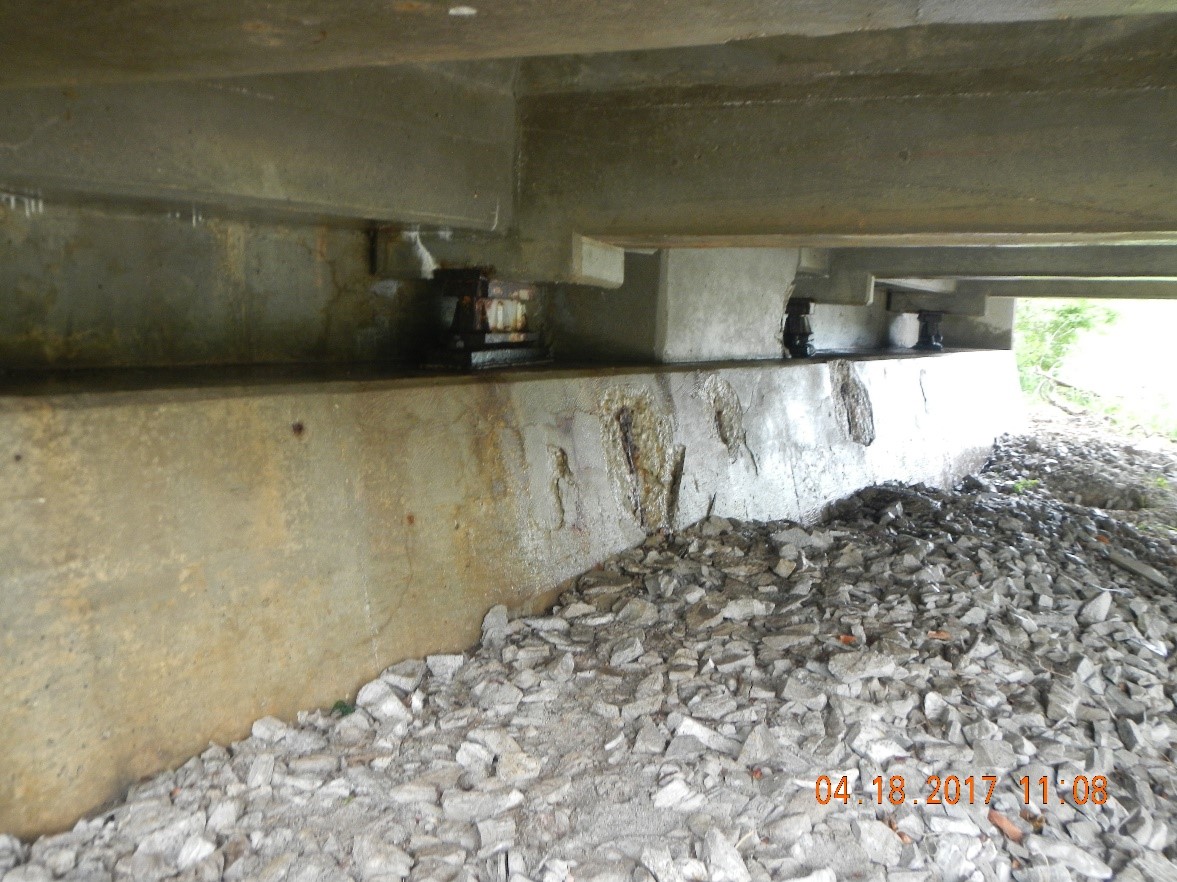
Concrete abutment after debris removal, cleaning, and washing
All of KYTCʼs bridge maintenance painting is done by contract. Recommending a site assessment prior to bidding is a great idea. Submitting questions prior to letting is another good idea. Pre-construction conferences assure that everyone is on the same page and that the contractor will perform the work according to the spec/proposal/plans. Proper scheduling is necessary to avoid disruptions during periods of high traffic volumes (e.g., workdays, holidays). Concrete bridge maintenance painting projects are complex and typically have eight work phases:
- Mobilizing the Painting Operation,
- Deployment at the Work Site (Field Operations),
- Preparation for Waste Handling and Disposal,
- Surface Preparation,
- Monitoring Atmospheric and Surface Conditions,
- Applying Coatings,
- Inspecting Work and Affecting Repairs, and
- Demobilization.
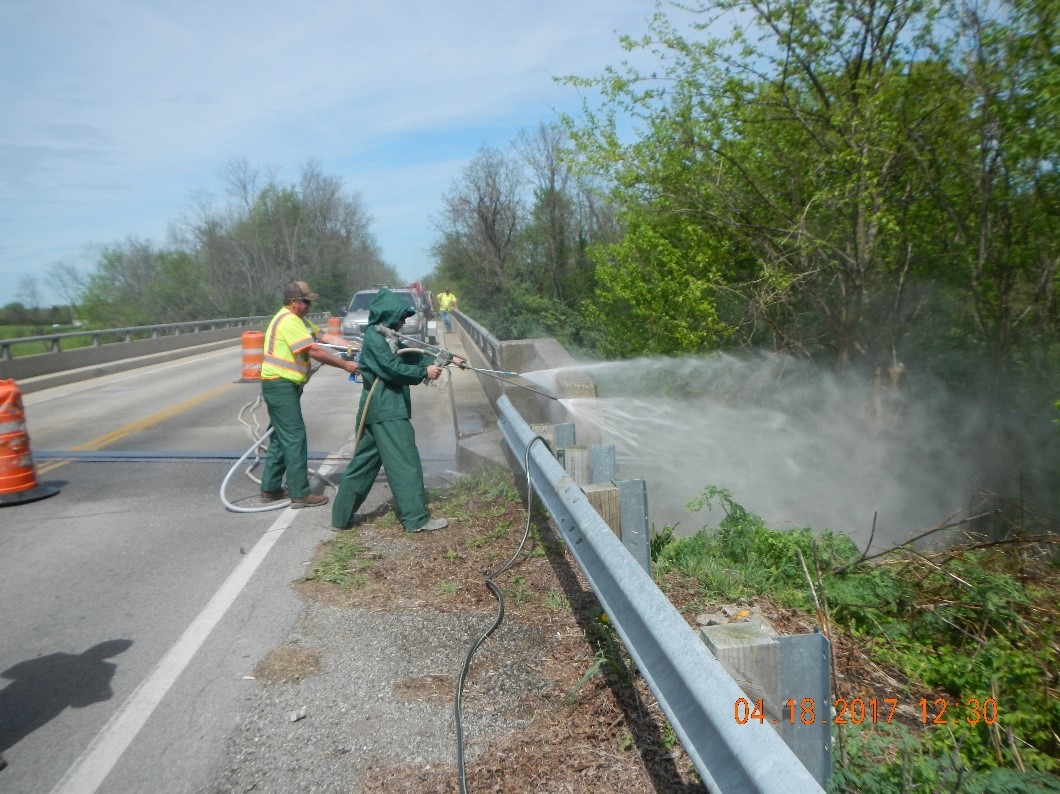

4.1 Monitoring Atmospheric & Surface Conditions
Before painting begins, workers must measure atmospheric and surface conditions to verify liquid coatings will not be applied to wet substrates. Rain, mist, fog, or condensation can deposit moisture on substrates. Coating manufacturers specify suitable environmental conditions for the coating application which may vary depending upon the coating type. A visual inspection is typically sufficient to detect surface moisture. However, the ambient relative humidity and surface temperature should be tested as well. Doing so helps workers avoid painting in conditions where condensation will moisten the surfaces. When substrates are moist, the applied coating does not adhere properly. Weather forecasts can indicate if rain is imminent and inform workers if they should delay painting operations. The relative humidity and surface temperature should be measured periodically to identify existing/imminent condensation threats — especially when the painting takes place at night. Because atmospheric conditions can vary at different locations on a bridge, workers are to measure relative humidity and temperature in the locations where painting will be done. Relative humidity and temperature measurements should be taken before and throughout the coating application process, to ensure that conditions have not become unsatisfactory since the start of coating application.
4.2 Applying Coatings
If atmospheric conditions are suitable and the concrete is properly cleaned, workers can apply the coatings. Coatings are mixed and agitated according to manufacturer instructions. Workers should prepare only enough coating to cover the concrete in the control area (e.g., a barrier wall). Prepared coatings must be applied within manufacturer-specified time limits (the pot life). Each coat must cure according to manufacturer directions before the next coat is applied. The current KYTC-specified coating system uses an epoxy primer with an acrylic topcoat. There is a limited time interval between when the epoxy first cures and can be topcoated and when it becomes too hard to accept a topcoat (the coating window). Once the interval has been exceeded, the hardened epoxy must have its surface roughened by sanding to receive the acrylic topcoat.
KYTCʼs concrete painting procedure normally consists of brush- or roller-applying liquid organic coatings onto the surface of structural concrete bridge members. However, spray painting may be considered when concrete coatings are used in containment enclosures in conjunction with remove-and-replace maintenance painting of steel bridge elements. A two-coat system is applied consisting of the epoxy base coat/primer and acrylic topcoat. The primer is applied first. Once it is cured, inspected, and then approved, workers can apply the topcoat. When applying a wet coating, workers can use wet film gauges to measure the coating wet film thickness. Measuring the wet film coating thickness during the application process helps to ensure that when the coating dries it will have manufacturer-specified thickness. If the concrete surface is too rough to measure coating thicknesses, the usage of the coatings can be measured over specific areas to get an approximation of coating wet film thickness. The contractor’s QC inspector must keep track of the coating pot lives and recoat windows to ensure proper coating adhesion and performance. Following the application and curing of each coat, the contractor’s QC inspector visually inspects the dried coating to detect flaws. Any flaws must be repaired before successive coats are applied. When possible, the contractor’s QC inspector also measures dry film thickness to verify the proper film build has been achieved. Thereafter, KYTCʼs QA inspector inspects the work and denotes rework or approves the work and painters complete the coating application phase of work.
Each coat has designated functions. The epoxy base coat/primer is used to bond the topcoat to the concrete substrate and provide protection against the penetration of deicing salts. The acrylic top coat resists atmospheric degradation (i.e., weathering) caused by direct exposure to the environment (wind, rain, abrasion, and UV radiation from sunlight) and protects the concrete against carbonation.
To achieve suitable coating performance, a continuous dry coating should cover concrete. While misses in coverage are not allowed, there is allowance provided for small surface voids i.e., bug holes. Each layer of coating must be applied to the manufacturer- specified thickness to ensure proper performance, especially protection of the concrete steel reinforcement. Once applied, a coating system should be free of visible defects (e.g., blisters, cracking, embedded debris). Using the two-coat system offers durability and should result in a service life of at least 20 years.
4.3 Inspecting Work and Effecting Repairs
Once KYTCʼs QA inspector approves the painting work, the Division of Construction’s bridge painting liaison (BPL) performs a final site inspection. The BPL reviews the coating work and notes deficiencies that require corrective action (e.g., paint flaws, paint spills on the ground, missed locations rigging scrapes). Contractors correct deficiencies before any containment or access rigging are removed. KYTCʼs BPL will examine remedial work, in consultation with the contractor, to verify its satisfactory completion.
4.4 Demobilization
Contractors remove work-related materials/wastes from the jobsite before leaving. They remove all waste storage enclosures once any waste and/or paint residues are taken for disposal or recycling. Waste found on the ground must be collected and disposed of in the proper manner. Traffic signs must be removed. If the surrounding environs have been disturbed, that disturbance must be remediated before a contractor departs the jobsite. A contractor must leave the jobsite in the same condition it was in before maintenance painting began.
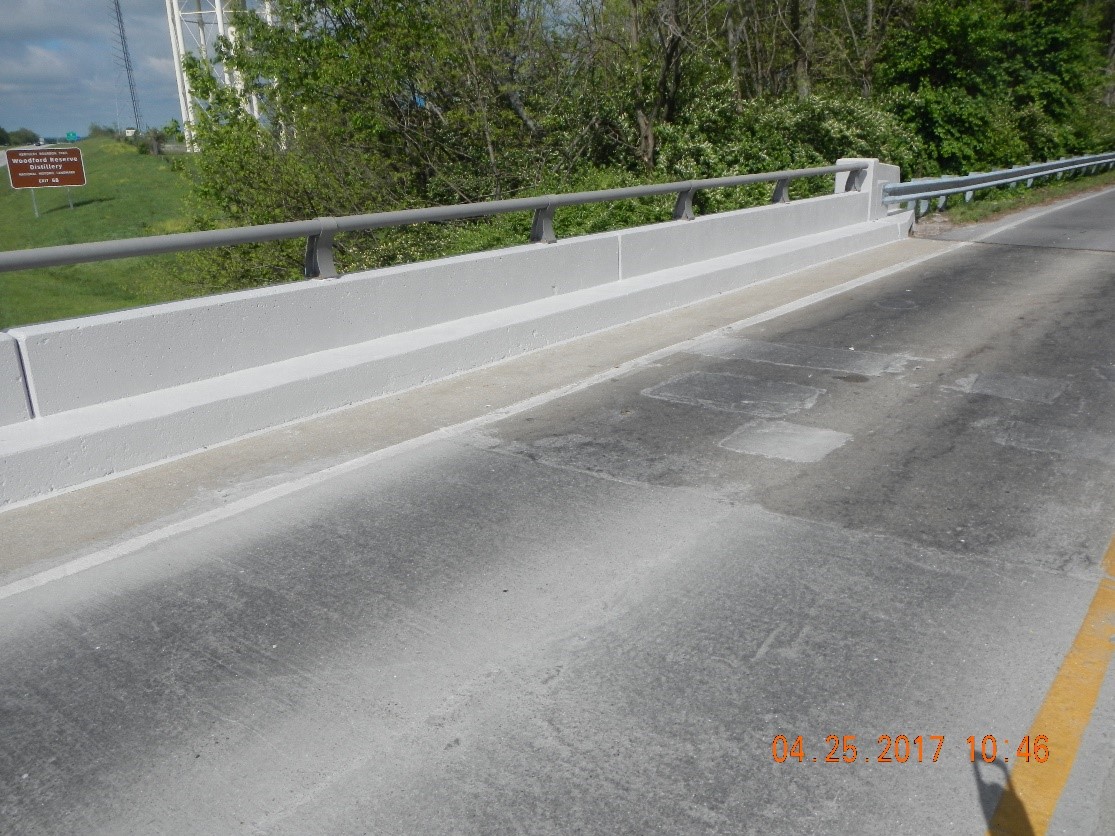
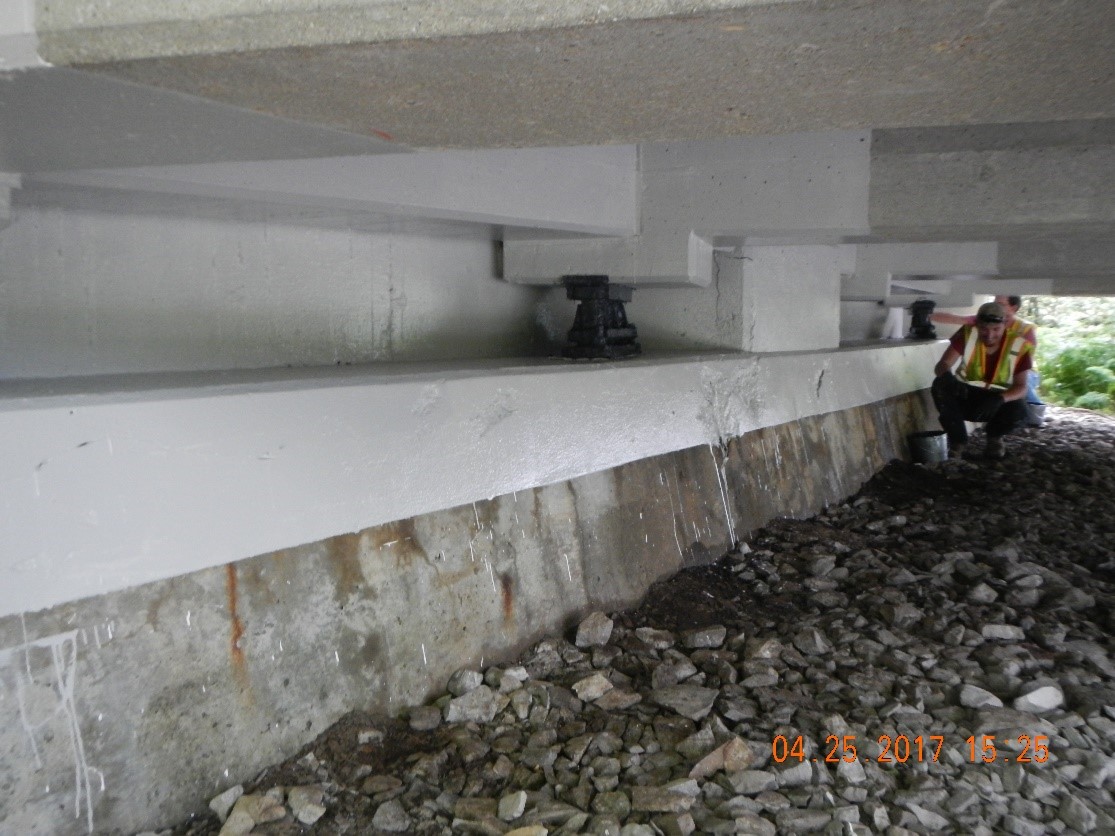
5.1 Inventory
KYTC conducts preventive maintenance, including maintenance painting, on steel and concrete bridges it owns as well as bridges owned by other jurisdictions. While the primary painting inventory is the Kentucky-owned group (structures designated with a “B” within the KYTC BrM database), various agreements or policies may include bridges from county, city, parks, railroad, or adjoining state inventories. KYTC is responsible for painting most of the bridges that connect to adjoining states; border state maintenance agreements are developed to fund these major projects.
KYTCʼs inventory of bridges specifies bridge type (e.g., multi-girder, non-redundant girder, pony truss, thru truss, deck truss, suspension, cable stay). Bridge type significantly impacts the complexity — and cost — of a painting project. The inventory also specifies the location of each bridge. Data are provided on latitude, longitude, stream crossed, route, intersecting route, and county. This information is important for programming maintenance activities as grouping bridges helps KYTC achieve economies of scale and improve project management.
Other useful information in the inventory includes vertical clearance, existing coating type, and condition of the existing coating. Data pertaining to coating condition should note the following: existing concrete surface treatment, current concrete condition (existing coating/type and condition, presence of laitance, or concrete distress such as spalling or cracking), failure location (beam-ends, fascia, general), and degree of failure (approximate percentage of area).
5.2 Programming
Employees developing and programming bridge maintenance activities must have knowledge of the funding sources which can underwrite their maintenance painting budget. Funding sources include:
- Maintenance (FE02) Budget,
- 6-Year Highway Plan, Special Projects, and
- End of Fiscal Year Adjustments.
Several factors influence the scope of the bridge painting program, including the available budget, project complexity, and market conditions (i.e., amount of work in the region). When making decisions about the program, the Specifier/Programmer also considers:
- Scheduling (spreading the work over various construction lettings),
- Contract administration in coordination with the Division of Construction,
- Projects requiring extended development (e.g., railroads), and
- Project time requirements (e.g., multi-season projects, completion dates, other projects).
Other considerations when developing the bridge painting program include:
- Disturbing lead on bridges by removal/replacement or encapsulating,
- Leaded residues that are to be recycled or sent to an appropriate waste facility,
- Distributing funding across KYTC districts,
- Reciprocal agreements with other bridge owners (e.g., states, cities, or parks), and
- Including rehab and/or repair
Historically, KYTC has adopted a continuous improvement approach, whereby newly developed materials and/or methods are incorporated into the painting program so that projects are completed in the most cost-effective manner possible.
As part of the bridge painting program individual bridge painting proposals go to letting. Proposals often encompass several smaller bridges. However, proposals for large bridges – such as Ohio River bridges — are usually limited to a single bridge or pair of bridges. When developing a bid proposal package for cleaning and painting projects, it is important to bear in mind that each bridge is unique. Some of the variables that may be included in proposals are:
- Construction details,
- Concrete condition,
- Steel condition,
- Coating condition,
- Presence of heavy metals,
- Protected habitats,
- Protected waters,
- Temporary traffic control issues,
- Sensitive environmental receptors,
- Worker access issues, and
- Oversize loads (e.g., farm equipment).

While biennial inspection data such as Structure Inventory and Appraisal (SI&A) provide some of this information, the individual developing a proposal should conduct an onsite visit to fully understand site conditions.
Helpful resources include:
- KYTC Standard Specifications for Road and Bridge Construction
- KYTC Standard Drawings
- KYTC List of Approved Materials
- KYTC Work Zone Safety Policy
- FHWA Manual on Uniform Traffic Control Devices (MUTCD)
- Other Industry Standards and Guides
KYTC maintains a list of prequalified steel bridge painting contractors. The bridge coatings industry has certifications for contractors and trades (e.g., coatings inspectors) which can be referenced to improve the quality of work.
While these resources are critical for developing a proposal-type bid package, Special Notes are the principal component. These notes address the unique characteristics of each bridge and specify a bridge’s location. Special Notes provide detailed explanations about the specific requirements for cleaning and painting a bridge.
- Kentucky Standard Specifications for Road and Bridge Construction
- Section 100, General Provisions
- Section 614, Maintenance Cleaning and Painting Steel Bridges
- Section 821, Structural Steel Coatings
- KYTC Bridge Inspection Procedures Manual
- Section 200, Inventory
- Section 300, Inspection
- KYTC Field Operations Guide (FOG)
- Section 812, Repairing Steel Bridge Members
- KYTC Maintenance Manual (MAIN)
- Section 806, Bridge Maintenance/Selection of Paint Color
- Section 808, Bridge Maintenance/Cleaning & Painting of Steel Structures
- KYTC Construction Manual (CST)
- Section 1314, Bridge Painting
- KYTC Structural Design Manual (SD)
- Section 501-3, Bridge Superstructure/Structural Steel
- Kentucky Methods Guidance Manual (KM)
- KM 64-256-08, Resistance Testing of Structural Steel Coatings to Methyl Ethyl Ketone
- KM 64-258-08, Measurement and Acceptance of Film Thickness of Structural Steel Coatings
- KM 64-263-08, Test Method for Analysis of Calcium Sulfonate
- KM 64-266-08, Performance Based Evaluation and Acceptance of Structural Steel Coating Systems
- KYTC Materials Field Sampling Manual (MFS)
- Section 522, Materials Field Sampling/Chemistry/Structural Steel Coatings
- KYTC Division of Materials Manual (MAT)
- List of Approved Materials (LAM), Concrete Coatings
- Section 403, Materials/Structural Materials Branch/Chemical Section

ACI (American Concrete Institute), Protection of Metals in Concrete against Corrosion, ACI 22R-01
ACI, Guide for Conducting a Visual Inspection Of Concrete In Service, ACI 201.1R-08
NACE (National Association of Corrosion Engineers), Coating Inspector Program Level 1
NACE No. 6/SSPC-SP 13, Surface Preparation of Concrete
The Society for Protective Coatings, SSPC Solvent Cleaning Guide
The Society for Protective Coatings, SSPC –2 Hand Tool Cleaning
The Society for Protective Coatings, SSPC – Guide 6, Guide for Containing Surface Preparation Debris
The Society for Protective Coatings, SSPC – Bridge Coating Inspector Program (BCI) Level 1
US Code of Federal Regulations, Title 29, Occupational Safety and Health Administration (U.S.) – Department of Labor (U.S.) 29CFR 1926 Safety and Health Regulations for Construction ISBN: 978-0-16092-897-0

